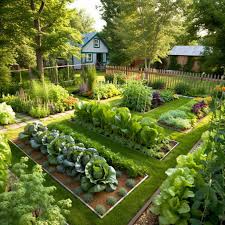The idea of having a vibrant vegetable garden, overflowing with fresh, homegrown produce, is a dream many gardeners share. However, turning this dream into a reality requires more than just planting seeds—it takes careful planning, commitment, and an understanding of the science behind gardening. Whether you’re a seasoned gardener or a beginner, following the right steps can help you create a flourishing garden. Here are 12 essential tips to guide you on your journey to a thriving vegetable garden.
1. Choose the Right Location
The success of your garden begins with its location. Most vegetables need at least 6-8 hours of direct sunlight each day, so pick a sunny spot. Make sure the area has good drainage to avoid waterlogging, which can cause root rot and other problems.
2. Prepare the Soil
Soil health is crucial for plant growth. Start by testing your soil’s pH and nutrient levels. Amend the soil with organic matter like compost or well-rotted manure to improve its fertility and structure. Healthy soil encourages strong, healthy plants.
3. Plan Your Garden Layout
Plan your garden layout to make the most of your space. Group vegetables that have similar needs, such as water and sunlight. Use raised beds or containers to improve soil quality and drainage. Companion planting can also help reduce pests and promote better growth.
4. Choose the Right Vegetables
Select vegetables that are suited to your climate and soil. Research which varieties thrive in your region and make a list of your favorite crops. Begin with easy-to-grow vegetables, then experiment with more challenging ones as you gain experience.
5. Timing Is Everything
Proper timing is key to a successful harvest. Know your area’s frost dates and plant accordingly. Some vegetables can be started indoors and transplanted, while others should be directly sown in the garden. Follow the recommended planting schedules for each crop.

6. Water Properly
Watering is crucial for healthy vegetable growth. Water deeply in the morning, allowing the soil to dry by evening to prevent fungal diseases. Mulch around your plants to conserve moisture and reduce the need for frequent watering.
7. Control Weeds and Pests
Weeds compete with your vegetables for nutrients, so regular weeding is necessary. Use natural pest control methods like companion planting, introducing beneficial insects, and applying organic pesticides sparingly to protect your crops.
8. Provide Support and Prune
Vegetables like tomatoes and cucumbers benefit from support structures such as stakes or trellises. Prune excess foliage to improve air circulation and reduce the risk of disease.
9. Fertilize Carefully
Over-fertilizing can harm your plants, so follow the guidelines based on your soil test results. Organic fertilizers, such as compost or aged manure, are great options for nourishing your garden while keeping it sustainable.
10. Practice Crop Rotation
Crop rotation helps prevent soil depletion and reduces the risk of disease. Avoid planting the same family of vegetables in the same location year after year to maintain soil health.
11. Stay Vigilant
Keep a close eye on your garden for signs of pests, disease, or nutrient deficiencies. Early detection and action can prevent problems from damaging your plants and your harvest.
12. Keep Learning
Gardening is a continuous learning process. Stay informed by reading books, attending workshops, or joining local gardening groups. Experiment with new techniques and vegetable varieties to keep improving your garden.
By following these tips, you can turn your dream of a lush, productive vegetable garden into a reality. Happy gardening!
